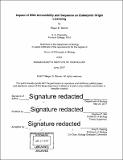Impact of DNA accessibility and sequence on eukaryotic origin licensing
Author(s)
Warner, Megan D. (Megan Dobbins)
DownloadFull printable version (12.43Mb)
Other Contributors
Massachusetts Institute of Technology. Department of Biology.
Advisor
Stephen P. Bell.
Terms of use
Metadata
Show full item recordAbstract
Eukaryotic DNA replication is a complex process that requires the coordination of many different proteins to ensure duplication of the genome occurs rapidly and only once during each cell cycle. Establishing a pair of replication forks moving apart from a single starting location is essential for replicating the genome. The first step in this process, termed origin licensing, occurs during G1. During origin licensing, two hexamers of the eukaryotic helicase, Mcm2-7, are loaded at potential origins of replication in a head-to-head orientation. They remain together, inactive, until entry into S phase. Origin licensing depends on three proteins, the origin-recognition complex (ORC), Cdc6, and Cdtl, as well as the DNA sequence present at potential origins. Although in S. cerevisiae, ORC binds to a known DNA sequence, where the other proteins, particularly the Mcm2-7 helicase, interact with DNA is not known. To gain additional insights into the initial placement of the Mcm2-7 complex, we used a method to create DNA-protein roadblocks at defined positions within origin DNA. Because both ORC and Mcm2-7 must encircle DNA, these roadblocks prevent stable DNA association. When a single roadblock was used, only defects in ORC-DNA binding were observed, despite that the Mcm2-7 helicase is known to encircle DNA. We hypothesized that sliding of intermediates in the origin licensing process could explain this discrepancy. When we tested this hypothesis by placing an additional roadblock to prevent sliding, severe defects in stable Mcm2- 7 loading, but not ORC recruitment, were observed. Interestingly, in the context where sliding was inhibited, the observed helicase loading was dependent on a particular sequence motif, the B2 element. This sequence is important for origin function in vivo, but a role in origin licensing in vitro has not previously been reported. Placing roadblocks around origin DNA was reminiscent of the nucleosome architecture present in vivo. These natural roadblocks behaved similarly to our artificial roadblocks, and origin licensing was dependent on B2 in both instances. These data suggest that origin licensing is a dynamic process and that the B2 sequence element is important when sliding of origin licensing intermediates is restricted.
Description
Thesis: Ph. D., Massachusetts Institute of Technology, Department of Biology, 2017. Cataloged from PDF version of thesis. Includes bibliographical references.
Date issued
2017Department
Massachusetts Institute of Technology. Department of BiologyPublisher
Massachusetts Institute of Technology
Keywords
Biology.